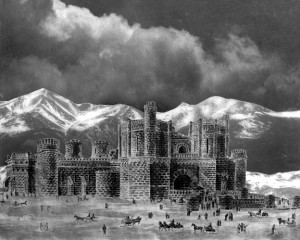by John Orr
Creede hydroelectric project
It makes sense to generate electricity with water and gravity where possible. Hydroelectric power is clean and as reliable as the water supply. Near Creede the A.E. Humphrey Ranch is going to get a shiny new hydroelectric plant for the dam there. Owner Ruthie Brown is ponying up over $900,000 in loans and federal stimulus dough to retrofit the dam her great grandfather constructed 90 years ago, according to a report from The Aspen Times.
The power generated will be enough to supply 230 homes. She is hoping to sell the power back to the utility grid. It’s hoped by those involved that the project will turn a profit after one year and demonstrate the practicality of small hydroelectric plants.
Geothermal lease sale near Mt. Princeton postponed
Renewable energy was a hot topic in the Upper Arkansas Valley recently. In November the Bureau of Land Management was set to lease nearly 800 acres for geothermal exploration but pulled the plug on the sale to accommodate a little more analysis of the potential effects on water and property rights. The next chance for developers to score a lease will be in February.
Buena Vista resident Steve Glover told the The Chaffee County Times that the industrial look and feel of a generation plant might ruin valley aesthetics. The arguments for developing the resource include having a low carbon footprint, proximity to a power grid for distribution and the hottest known water source in the state.
San Luis Valley: Final arguments presented in first groundwater sub-district trial
The management rules for the sub-district are the subject of the trial. Senior rights holders are arguing that the rules as set up will not compensate them adequately for past curtailments. Surface water irrigators have been responsible for compliance with the Rio Grande Compact — the contract that governs the accounting for water delivered by Colorado at the New Mexico border — while wells were unregulated. Pumpers argue that they were pumping legally in the past and should not be held to pay for past depletions.
The Pueblo Chieftain reported that Attorney Tim Buchanan, who represents the 11 objectors, panned the computer model to be used to calculate diversions by saying, “Is it math or is it voodoo?”
The alternative to the groundwater sub-districts would be a set of rules handed down from the Office of the State Engineer as has happened in the South Platte Basin.
Senator Udall introduces good samaritan legislation
The central argument simplified: Some, primarily local groups that want to clean up their watershed, want a relaxation of the Clean Water Act. Others, those that feel that waiving environmental laws defeats the intent of that category of law, do not.
Risking his relationship with environmental groups Colorado’s senior senator is trying to get a bill, S.B. 1777, through the Congress. It will allow groups to operate mine cleanup projects under a Good Samaritan permit by relaxing Clean Water Act requirements. As the law stands today if you worsen a situation with a cleanup effort you may end up owning the problem. The Cortez Journal quoted the senator as saying, “Any time you get your hands wet, you’ve triggered the Clean Water Act and Clean Water Act liability issues.”
Udall’s bill will not allow a site owner to apply for a permit. Superfund sites, likewise, cannot apply.
Leadville Mine Drainage Tunnel
U.S. Representative Doug Lamborn has introduced H.R. 3123, the Leadville Mine Drainage Remediation Act of 2009. The bill will direct the U.S. Bureau of Reclamation to take responsibility for treating water laced with cadmium, zinc and lead from the entire length of the tunnel. Lamborn also wants Reclamation to treat water from other sources at the California Gulch superfund site. His legislation should clear up the roles in the dispute between the Bureau of Reclamation and the Environmental Protection Agency around treating the acid mine waste prior to discharge into the Arkansas River.
2009 water year
October 31 marks the end of the water year. Division Engineer for Division III, Craig Cotten, told the Rio Grande Water Conservation District board that the snow melted off early this year, in the Rio Grande Basin, due to dustier snowpack conditions and a warm May.
Irrigators had a good year. “We only had a month of curtailment on the Rio Grande this year,” said Cotten, according to the Valley Courier. The Conejos River system was only curtailed for one month. “We also had the entire suite of ditches in priority and diverting. The most junior priority on the Conejos system diverted for almost three months this year,” he added. He expects both systems to over-deliver the amount of water required by the Rio Grande Compact.
A report in The Pueblo Chieftain said that the mainstem of the Arkansas River saw three separate peak flows this year, which created steady high flows rather than sudden high rushes. By the end of October Pueblo County had received 15.5 inches of precipitation, way above the average of 11.28 inches. By the middle of October the Bureau of Reclamation was clearing space in Twin Lakes and Turquoise Lake by moving water to Lake Pueblo in anticipation of making room for 2010 imports from west slope headwaters through the Boustead Tunnel.
Short takes
• Happy 20th birthday to the Arkansas River Headwaters Recreation Area. The 148 mile long recreation area stretches from Lake County to Lake Pueblo and is owned by the Bureau of Land Management and operated by Colorado State Parks.
• Happy 10th birthday to Black Canyon of the Gunnison National Park. Of the milestone, Superintendent Connie Rudd said, “What’s important is that the canyon is still the same and that means we’ve done our job,” according to the Montrose Daily Press.
• Restoration work along Fooses Creek and the South Fork of the Arkansas River was finished up in August. The Collegiate Peaks Anglers and Cheyenne Mountain chapters of Trout Unlimited along with Xcel Energy and the Colorado Division of Wildlife financed restoration of 116 sites along the two streams, creating pools about three feet deep.
• The Lake Fork Watershed Group has completed plugging the Dinero Tunnel which was leaking acid mine drainage into the Lake Fork of the Arkansas River. Next up is a “sulfate-reducing bioreactor” or artificially constructed wetland at the Tiger Tunnel. They’re trying the wetlands idea because the tunnel’s rock is not strong enough for a plug.
• Nestlé Waters’ Chaffee County Project is fully permitted from the county now. Next up is water court for an augmentation plan.
John Orr follows Colorado water issues at Coyote Gulch. (http://coyotegulch.net)

